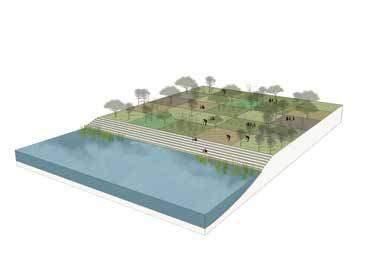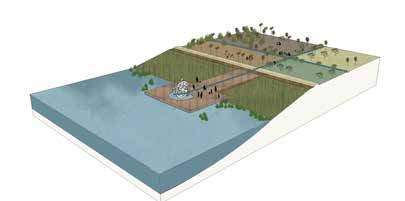
6 minute read
The immersive process
Visitors generally start at the railway station, with Iron Age themed crops and programs. Every themed zone ends with a themed restaurant, where self-harvested crops are prepared spontaneously. Every exit from a restaurant reveals a new era further down the course of history. Therefore, the visitor experiences a total of six eras from past to a possible future, experiencing varied recreational activities depending on the time of the year, and taking in a 6-course meal in the process.
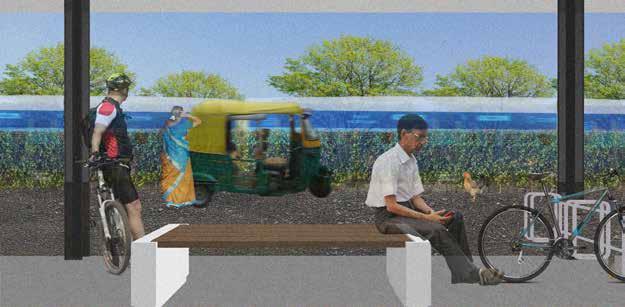

Iron-age fields sHIFTING sEASONS; sHIFTING cROPS




Marigold fields and spa pods

High-tech restaurant & step-pool/open space sHIFTING pROGRAMS; sHIFTING eXPERIENCES


Eingeel Jafar Khan
Re: weave - cultural revival of yelahanka old town through injecting tourism as a booster
Historically known as the city of gardens, lakes, and culture, Bangalore, while moving towards rapid urbanization, has been adopting a more global outlook. The multicultural Indian city has had a lifestyle deeply rooted in its religious context where in the places of worship became the main nodes of social and economic activities. But amidst this shift, a question that needs pondering is whether Bangalore is losing touch with its cultural roots?
The old town of Yelahanka in Bangalore is gearing towards the same kind of shift. Known for its surrounding foodscapes of paddy, rice, millet, guava and grapes among other crops, Yelahanka is also known as the Manchester of Bangalore. Being a traditional place for weavers, the silk handloom industry has been the lifeline of the people for over two centuries and is also presently carried out in the North areas of Kamakshamma layout, Agrahara layout, Kogilu and Chowdeshwari layout. Integrating these tangible and intangible facets of the cultural ecosystem of Yelahanka while ecologically and economically reviving the neighbourhood is the main challenge.
The old inter-generation resident families of the place connection with agriculture and the lakefront complained of their long working hours inside the homes devoid of any recreational open space nearby for small work breaks. They miss the olden ways of saree making where in parts of the weaving process used to be carried out in semi-open and open lands (dyeing, drying and reeling threads). The community survey and onsite mapping also revealed that the religious places were the main hubs of social and economic activities, with most of the people going to them either once a day or frequently in a week--for worship, for social gathering, or for buying merchandise from stalls nearby. Hence, it was evident that Yelahanka as a neighbourhood has all these three factors as the backbone of its socio-cultural-economic fabric.
My design strategies are aimed at the ecological, cultural and economic revival of the place through augmenting biodiversity, socio-cultural relations, and local tourism; each building upon each other as part of a big system. For the first sphere of ecology, I aim to introduce the circular lifecycle design process wherein the source to end waste product is produced and utilized at site. The flower waste produced from the places of worship would be utilized in the dyeing process of the weaving industry along with other eco-dyeing crops grown in Yelahanka, and the coconut shell waste produced would be utilized in making craft products from the coir. Creating active open spaces and various pause points for residents and working weavers in conjunction with existing nodes of religious places is aimed at the second core sphere of culture and society. The last strategy of augmenting local tourism through weaving the three cultural elements of Yelahanka together, namely weavers, agriculture and the religious ecosystem is aimed at the third core sphere of economics.
Strategy 2 Strategy 1
Connecting the disjointed patch matrix system of Yelahanka through corridors of edible landscape along wth waste management
(AUGMENT ECOLOGY)
Strategy 3
Weaving the three cultural elements of Yelahanka together: Religious + Weavers + Agriculture ecosystems
(AUGMENT ECONOMY THROUGH TOURISM)
Process Weavers + Religious hubs + Vacant lands


Giving functions based on 3 ecosystems and connecting them through a trail
Weaving Religious Agricultural
Further diving the functions into detailed zones under each ecosystem

Eingeel Jafar Khan
Tourism With Its Elements As A Tool For Revival
Tourism will act as a booster to Yelahanka, pushing forward the revival process wherein the tourists from downtown and the larger region come to sensorially experience the inter-connected religiousweaving-agriculture ecosystem, and in turn be educated about the various processes involved.
Wayfinding elements

Seating along trail Signage Trail Material: Permeable detail plan
Legend
Break point 1 and flower waste centre detail plan
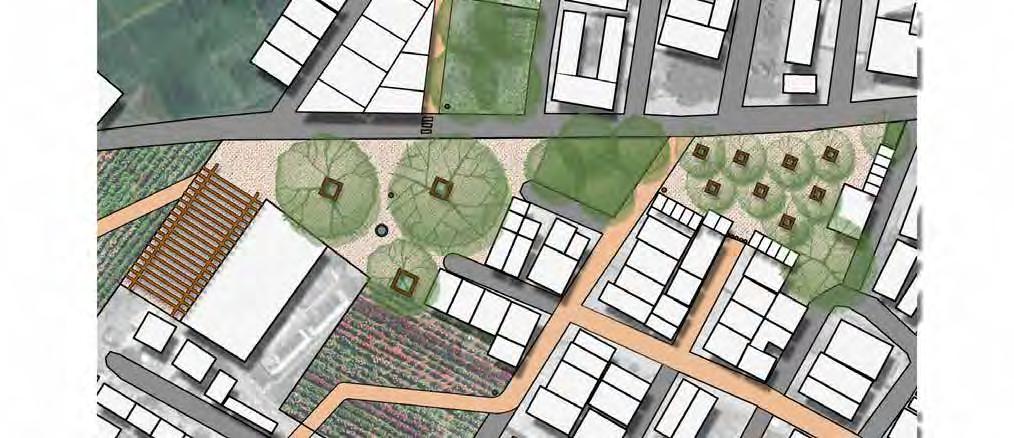
Neem Tree (Azadirachta indica)


Eco- cultural Trail (colored permeable stone paving
Pergola for drying Dyed Raw Silk and Rain Shelter
Peepal Tree (Ficus religiosa) Mango Tree (Mangifera indica)
Permeable stone paving
Flower Waste Centre
Flower Farms (Jasmine, Marigold and Hibiscus)
Sensorial Experience along the Trail

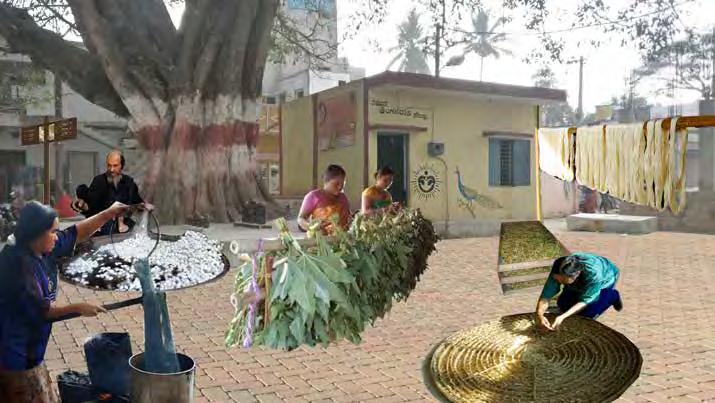


Dong Yitong
Continuous Productive Urban Landscape (cpul) in Yelahanka

What is needed: Improve people's awareness. Restoration and protection of the ecosystem.
How to do it:
Build green space system. Community garden as medium.
Dong Yitong Master Plan
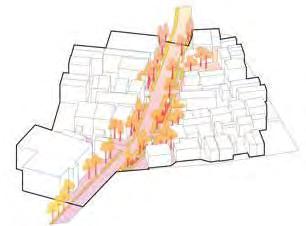




Current situation detail plan

Dong Yitong Little fingers
Phase 1: Full use of vacant land
Half-closed vacant land & connection
Half-closed vacant land near the street
Small area vacant land



Connection with linear park

Functional zone
Interconnectivity
Cow gathering area
Main Street
Dong Yitong
Use building facedes for vertical garden
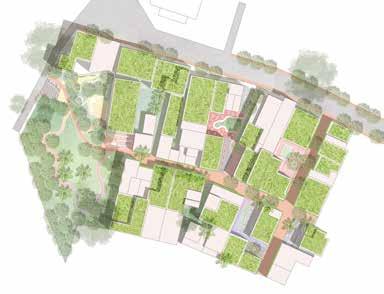




Design process

Community
Orchard
Mainly responsible for supply of plant dyes; the garden primarily produces fruits and vegetables that can be made into vegetable dyes
Flower Garden
Mainly responsible for supply of plant dyes, flowers such as tulips and morning glorys are very good natural dyes after treatment. At the same time, it can provide an excellent experience for tourists.
Herb Garden
Mainly responsible for supply of vegetable dyes. Many herbs have great potential for use in dyeing, which enables tourists to learn more medical knowledge while visiting.
Water Treatment

Although Eco-Dyeing, the process of dye production will use a small amount of chemical agent to improve the color of the dye durability. The lightly polluted water needs to be treated.
Cotton Field
Mainly provides cotton, so that visitors can have a better understanding of the raw materials of the fabric. The cotton produced here can be used in the workshop
Central Workshop
An area for various textile activities. Visitors can learn about the extraction of vegetable dyes, the coloring of fabrics, and the making of fabrics. These paid activities can also promote and increase the income of local residents.
Mulberry-base pond
Mulberry trees were planted in large Numbers to guarantee the production of silk, and fish were raised in the fishponds. Tourists could do all kinds of waterloving activities such as fishing.

Li Ziheng
Plant selection for dyeing
The choice of plants is very important. Apart from cotton and mulberry trees, which provide fabrics, other plants selected can be used for dyes. The roots, leaves, stems, fruits/peels, and petals of these plants can be used as natural dyes. Also, plants should be chosen for their agricultural qualities, such as apple trees: the fruits can be eaten and the flowers can be used as dyes, making them ideal for growing in fields.


Interlake - Amplifying The Strength Of Connection Between Community And Yelahanka Lake By Amalgmation Of Productive And Ecological Landscapes
In between understanding the lake series developed throughout Bangalore, the system of lakes helped to know why and how they were built for rich landscape assisting socio-economic aspects. The primary purpose of the lake series faded away with the development of the lake city, creating barriers and destructing the lake series. Even though the authorities tried to keep the buffers for a revival of this lake series the sense of belonging to the lake has mostly diminished. That’s why the part of the design was redefining these boundaries and utilising them to nurture the whole lake series of Bangalore and set up an example to follow.
Though rapid urbanization was taking over such significant features in the town, Yelahanka lake and the stories told by the communities maintained to trace the importance of Yelahanka lake within the community, which inspired me to come up with an intervention that reframes the past by linking the city to the lake and surrounds. The lake served the community for cultural and economic reasons in the past, and the challenge was reintroducing the lost bond with a new expression to engage present and future generations. The strategies revolve around giving access, the original purpose by building and activating edges and sharing the resources to build community.
Past conditions : Multi crop farming
Past conditions : Urban influence
Decline in farming activity
Present conditions : Unorganized development

Encroachment
Gated lake area

High contaminated soil and ground water
Proposed phase 1 : 5-6 Years
Phytoremediation to extract contamination and improve soil quality for productivity
Creating green buffers to purify the surface runoff from surroundings

Proposed phase 2 : 2-3 Years


Post extraction process using the land for production
Proposed phase 3 : 1-2 Year
Planting fast growing + nitrogen fixing trees to increase soil quality And again using for production






